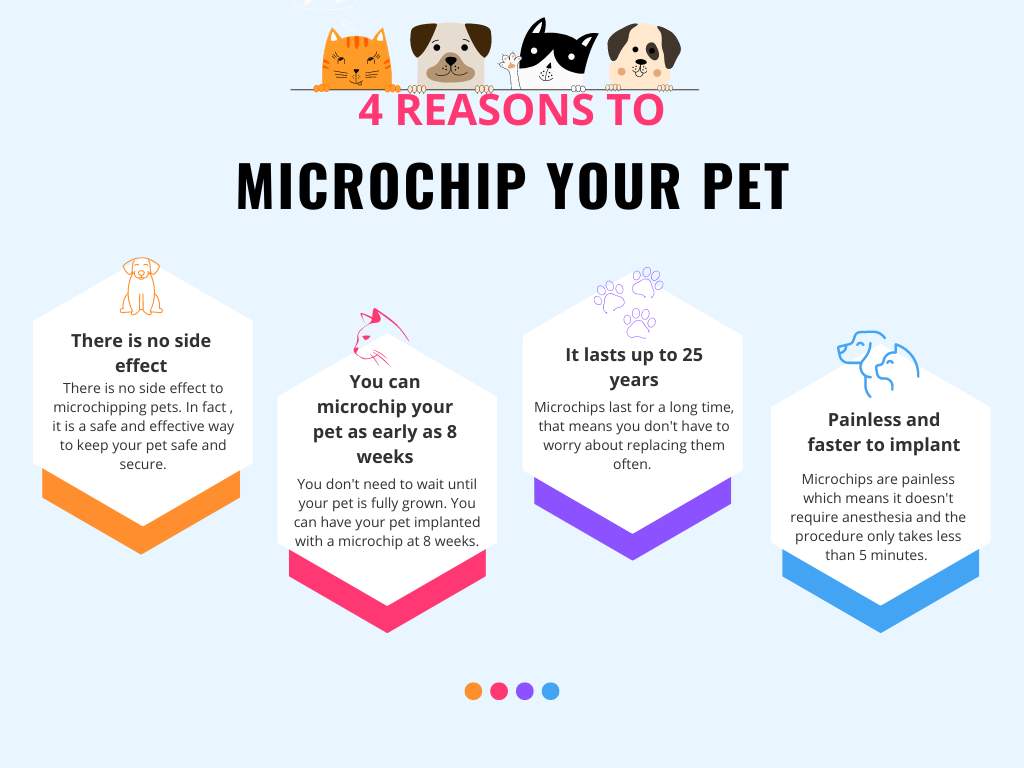Lost Pet: The Art of Microchipping Your Pet
Introduction
It was a day like any other when Sarah received the news that her beloved dog, Charlie, had gone missing. Her heart sank, and her mind raced with questions: Where could he be? Will he find his way back home? What if someone found him but had no idea who he belonged to? These thoughts led her to explore the world of pet microchipping, an invaluable tool for reuniting lost pets with their owners.
Microchip implants are tiny electronic devices, almost the size of a grain of rice. They serve as a form of identification tag, allowing pet owners to identify their pets when lost. The chips contain information about the owner, including contact info, name, address, phone number, etc. If the dog gets lost, the microchip allows authorities to find the pet quickly. This is how important microchipping your pet is. An estimated 80% of dogs in North America are microchipped. This includes pets, shelter animals, and even wild animals.
A microchip contains unique identifying information such as the animal’s registration number or other data specific to the individual animal. They’re inexpensive (about $20) and easy to administer. The implant lasts anywhere from 5 to 25 years, depending on the type of chip used.
A microchip is usually inserted below the skin between the shoulder blades or into the subcutaneous tissue of the neck but may also be placed elsewhere on the body. No needles are involved; they are done under the skin without anesthesia and take less than five minutes. Once implanted, you must register your pet chip with a national database so it can be returned more efficiently if your dog ever goes missing. Unfortunately, according to recent research, just 58% of microchipped animals have been registered.
The chip is read by a scanner which sends the information to a central computer where it is registered. The information stored on the chip can include the owner’s contact details, breed, age, weight, color, sex, vaccination history, medical records, pedigree, DNA profile, and other relevant information.
There are two types of microchips available today—passive and active microchips.
- Active microchips use a battery-powered transmitter inside the chip. The chip emits a low-frequency signal that a particular handheld reader can pick up when activated. The reader then sends the information to a computerized database.
- Passive microchips do not require batteries. Instead, they rely on the energy emitted by a small antenna located within the chip. A passive chip will emit a radio frequency signal whenever its antenna receives a strong enough electrical current. The reader uses this signal to send the information to a computer.
Microchips are safe and effective. There are no known health risks associated with them. However, some worry about whether the chip could cause cancer. While it’s true that certain types of radiation can increase the risk of developing cancer, the amount of radiation received from a microchip is exceptionally minimal.
How Do Microchips Works
Microchips are small devices that are surgically implanted into animals. They contain information about the owner and their pets. For example, when a dog wanders from home, your pet’s microchip is scanned by a microchip reader from the shelter or veterinary. If the scan matches the chip, the pet is returned to its owner.
Once installed, microchips are virtually invisible. They’re usually placed under the dog’s neck fur, behind her shoulder blades, or near her hind legs.
And because they’re so small, they won’t interfere with everyday activities. So no matter how active your dog is, she’ll still be able to run, play fetch, swim, jump, climb stairs, etc., without worrying about getting hurt.

This technology makes finding lost dogs faster and easier than ever before. And because it’s permanent, there’s no risk of losing your dog again. It also helps reunite pets with their owners.
The process of implanting a microchip into a dog is quick and painless. After you bring your dog to a vet, he will apply numbing cream to the area around the implant. Then, the vet inserts a needle into the skin and injects the microchip into the muscle layer. Once the chip is inserted, the vet covers the wound with a bandage.
Several different companies provide microchip scanners. You can buy one online or at most veterinary clinics. Some scanners cost less than $100; others run up to hundreds of dollars.
Dogs That Need to be Microchipped
Microchipping dogs and cats are required for those over eight weeks old. If you want to adopt a dog, make sure it is microchipped. This includes puppies under six months old. All dogs should be microchipped before they go into the kennel. Impounded dogs must be microchipped again within seven days of being returned to their owner. If your dog is impounded twice, it will require a new microchip.
If your dog has been missing for more than 30 days, consider microchipping him. However, if your dog was found after 30 days but not reclaimed by its owner, you may have to pay an additional fee to have another microchip implanted.
Microchip Registry Database
Microchip registration should be done as soon as your dog has been implanted. You need to register the chip’s unique identifier with a national pet recovery database to do you any good. You’ll want to use a service with access to several microchip databases and technologies. A service like this is available.
All cats and dogs need a unique number called a registration tag. These tags are issued by the American Kennel Club (AKC). The AKC requires that each dog be registered with the organization.
You can register your dog through the AKC website. You can choose between registering your dog as a purebred or mixed breed. Purebred dogs are those whose parents were both registered members of the AKC. Mixed-breed dogs are those whose parents weren’t registered members.
Registration tags come in two sizes: standard and miniature. Standard tags are more significant than miniatures. Both types of tags include a serial number used to identify your pet.
Registration tags are available from veterinarians and pet stores. Prices vary depending on the size of the tag. A standard tag costs anywhere from $10 to $30, while a miniature tag runs between $5 and $15.
Why Is Pet Microchip Important

Microchipping your dog is essential as they contain information about your pet’s breed, age, vaccination history, and owner contact information. This data helps veterinarians or animal shelters find your missing pets quickly. In addition, a microchip makes reuniting them with their original family easy.
The best place to implant a microchip is just beneath the skin on the underside of your dog’s neck. This is called subcutaneous placement. There are several advantages to this method.
- It’s less painful than implanting it into muscle tissue.
- It’s easier than placing it inside the chest cavity.
- It’s less likely to cause infection.
- It’s less expensive than implanting it directly into the bone.
Pros of Dog Microchipping
Microchip technology has been around since the 1950s, but it wasn’t until recently that it became mainstream. There are now over 10 million dog owners in the United States alone. This number continues to grow every day. So what exactly does microchipping do? And why should you consider getting one for your pet? Here are four benefits of microchipping your pet.
1. You Can Prove Ownership
If your pet is lost, he could be adopted into someone else’s home. If that happens, you won’t know where your dog came from. But if you microchip him, you can prove his identity. You can show proof of ownership when your dog is returned to you.
2. Dogs who wear microchips are easier to find when lost or stolen
The chances of your dog getting lost are much lower if he has a microchip implanted under his skin. A microchip contains information about the pet owner’s contact information, medical history, vaccination records, and even breed. If your dog ever goes missing, law enforcement officials can use the chip to find out who owns him.
3. Microchip Procedures are Painless
This procedure is generally easy for dogs. It is usually done by inserting a needle into the skin at the base of the neck. The chip is then inserted into the body using a syringe. Afterward, the area is cleaned and bandaged. Most dogs recover within 24 hours.
4. Microchips are Inexpensive
You can get a microchip for your dog for as little as $20. That price includes everything you need to complete the procedure. Some vet clinics will also offer free microchipping services.
5. Microchipped Pets Stay out of Shelters and Rescue Groups.
When your pet goes missing, you scan its microchip at any shelter or rescue group. Your pet’s owner will be notified immediately and reunited with them.
If your pet ever becomes lost, it will return home faster. And because microchips are implanted beneath the skin, there’s no risk of infection or injury.
Cons of Dog Microchipping
Microchipping is a great way to keep contact and track your pet. But there are some disadvantages to it. Here are three things you should know about microchipping.
1. Your Dog’s Microchip Can Move.
When your dog gets lost, animal care professionals look for microchips near the collar. But sometimes they don’t find them. That means your dog may have gotten separated from their owner. To prevent this problem, you need to put your dog’s microchip in a secure location. It should be placed so that it won’t move during everyday activities.
2. Different Chips Emit Different Signals.
Microchips are tiny transponders implanted in pets’ ears. They’re used to identify lost pets and reunite them with their owners.
Different microchip companies use different frequencies to transmit information. The frequency emitted by each company varies slightly, so when you find a pet, you need to be able to tell whether it was chipped at a particular company.
There are two types of microchips: passive and active. Passive microchips use radio waves to transmit information. Active microchips use battery power to send out a signal.
Some microchips are passive, meaning they send out a signal when scanned. Passive microchips are cheaper than active ones because they require no batteries. However, they could be more effective at transmitting information over long distances.
Others are active, sending out a signal whenever they receive power. Active microchips are better at sending information over long distances. But they cost more than passive microchips.
3. Microchips Don’t Work 100% of the Time in Dogs
If you’re going to microchip your dog, be prepared for problems. The most common problem is that the chip only works sometimes. This happens because the battery inside the tag dies after a specific time. So, if you use the microchip for identification purposes only, you should consider getting a replacement tag.
Another problem is that the chip might get damaged. For example, if your dog falls into the water, eats something toxic, or gets bitten by another animal, the chip could become damaged. As a result, 42% of microchipped pets are still at risk of becoming lost. In these cases, you’ll need to replace the chip.
How to Get My Pet Microchipped
There are two ways to get your dog microchipped: through a veterinarian or a pet store. Both methods work equally well. To get started, visit your local vet or animal hospital. Ask them whether they offer microchipping services. If so, ask how much it will cost. Some vets charge more than others.
Also, ask about their policies regarding refunds. Many vets require a deposit before performing the procedure. Others allow you to pay after the process is completed.
If your vet doesn’t offer microchips, look for another veterinary clinic nearby. Or, try an online veterinary service. These companies typically have competitive pricing and offer free shipping.
How to Microchip Your Dog
The microchip is one of the most important things you can do for your dog. A microchip is a small device implanted under your dog’s skin. This chip contains vital information about your dog, including his name, breed, age, vaccination history, and owner information. If your dog ever gets lost, someone can scan the chip to find out where he belongs.
Ask your veterinarian to perform the microchip procedure. You can also learn how to do it yourself here. Ensure you provide enough information to make it easy for people to identify your dog. For example, include his name, breed, color, size, weight, and distinguishing marks. Also, include your phone number and email address.
Check your pet’s microchip annually. Your vet can check the chip for accuracy and update it if needed. Don’t forget about your pet if she goes missing. Keep her collar and tags up to date. Contact your local animal shelter or humane society to see if anyone has reported your dog missing.
Frequently Asked Questions About Microchips
Disclaimer: The information provided on this veterinary website is intended for general educational purposes only and should not be considered as a substitute for professional veterinary advice, diagnosis, or treatment. Always consult a licensed veterinarian for any concerns or questions regarding the health and well-being of your pet. This website does not claim to cover every possible situation or provide exhaustive knowledge on the subjects presented. The owners and contributors of this website are not responsible for any harm or loss that may result from the use or misuse of the information provided herein.







